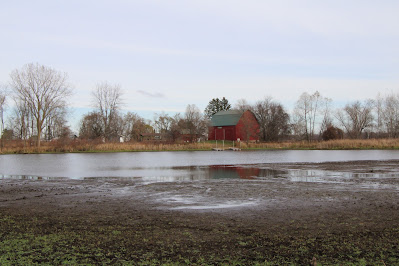To avoid a stray bullet from an aimless deer hunter, I’m hiking in the Hiawatha Hills Preserve, a 5-acre, semi-residential parcel, located four miles west of Mt. Pleasant. The early morning weather is cold and cloudy as I scan the landscape that can best be described as an Ash Tree graveyard. Thirty years ago, this place would have been a dense woodland dominated by tall, healthy Ash trees (stock photo). Since then, the larvae of the Emerald Ash Borer (stock photo) has infected, girdled and killed all of them that are now seen as large grey trunks sprawled on the ground in various stages of decay. Moving a short distance, I come to the edge of the Chippewa River and pause to look at and listen to its flowing water. Along the bank, I observe the trunk of a dead tree, most likely killed by Bootstrap fungi. Honey mushrooms are parasitic on live wood and send out these long root-like structures between the wood of a tree and its bark, killing the tree. When fresh, these roots are cream colored but darken to brown or black as they age. The fungus is also called root rot or shoestring root rot. Exploring the flood plain, I spot a green rosette of Wild Radish. This plant is non-native and invasive in Michigan. Depending on the season, the entire plant is edible, including leaves, roots, blossoms and the segmented pods that have a radish-like taste (stock photo). Moving away from the river, I come upon a small pile of red feathers from a Northern Cardinal, most likely the leftovers of a predator-prey confrontation between this bird and a hawk or owl. Other observations, include an old, hard 8-inch Artist Conk shelf fungus and a patch of Pixie cup Lichens. Nearby, in contrast to much of my drab-colored surroundings, I notice the red-orange leaves of a Barberry bush and remember the bright red fruit it displayed earlier in the season (stock photo). Leaving this preserve, I take a short drive to the other side of the river to the 2-acre Neyer Preserve where I hike past American Beech and Canadian Hemlock trees. Downstream, I spot mounds of white foam on the water surface. These natural suds result from higher levels of organic decomposition this time of year forming these dense masses of air bubbles. Along the far shore, I watch a few whitetail deer scamper in single-file below a river-front house. While heading back to the car, I pause to enjoy the quietude and scenery of this riparian ecosystem. From here, the Chippewa flows another 30 miles east before converging with the Pine River at the Chippewa Nature Center near Midland.
Early December days
Neath leafless trees
Nature at attention
Mother Earth at ease
Beside a shrinking pond
No frogs with leopard skin
Atop the meadow grass
No spider webs to spin
Squirrels of woodlands
Prepare for winter’s blast
Hoarding their food
Autumn breathes her last
D. DeGraaf




